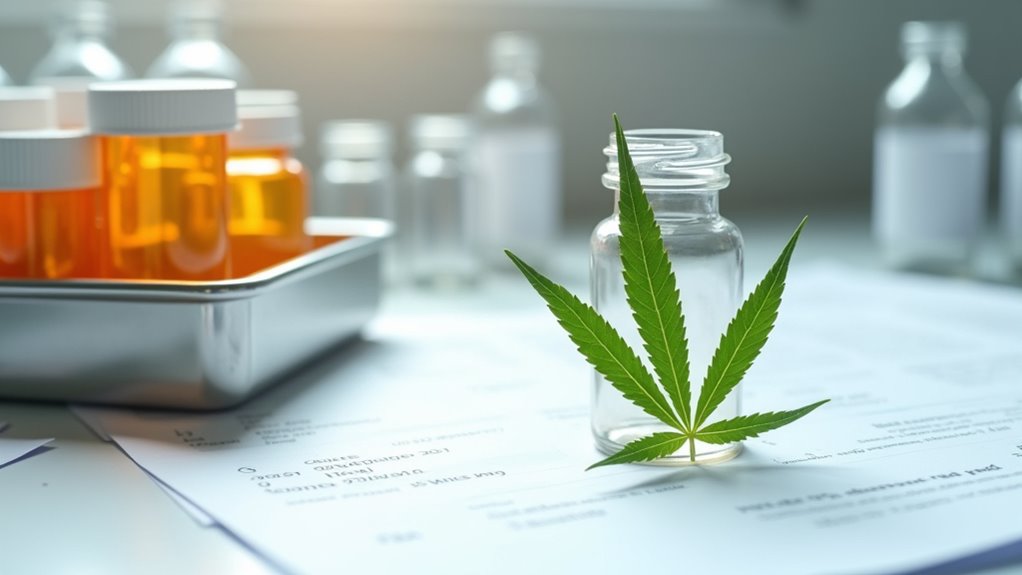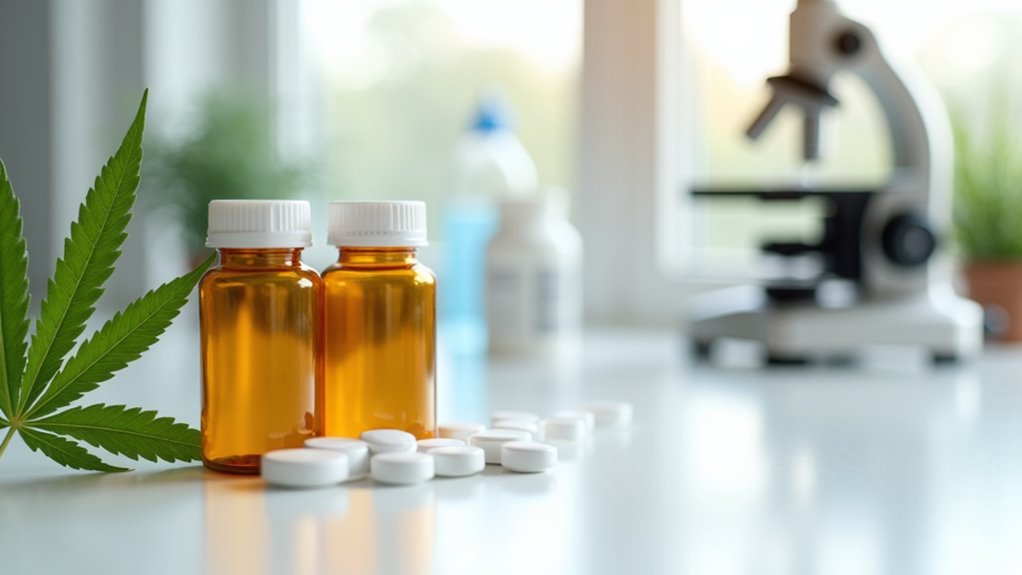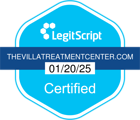Currently, there aren’t any FDA-approved medications specifically for treating marijuana addiction or cannabis use disorder (CUD). However, healthcare providers may prescribe several medications “off-label” to help manage withdrawal symptoms and cravings. These include naltrexone, varenicline, and N-acetylcysteine, though their effectiveness varies among individuals. While behavioral therapy remains the primary treatment approach, promising research into new pharmaceutical interventions offers hope for expanded treatment options in the future.
Current FDA Status on Marijuana Addiction Medications

While the FDA has approved several cannabis-derived and synthetic cannabinoid medications for specific medical conditions, there are currently no FDA-approved medications for treating marijuana addiction or cannabis use disorder (CUD). Existing approved drugs like Epidiolex (cannabidiol) and Marinol (dronabinol) target other conditions such as seizure disorders and chemotherapy-induced nausea. Researchers seeking to study potential addiction treatments face additional hurdles since cannabis remains Schedule I, requiring special DEA registration and sourcing from a single approved facility.
Recent data indicates 1.64 million individuals have received inpatient or outpatient treatment for cannabis use disorder.
The lack of targeted therapies for CUD affects over 2 million U.S. adults annually, highlighting a significant treatment gap. While researchers investigate new combination therapies through clinical trials, current treatment relies primarily on behavioral interventions.
Two promising investigational drugs, PP-01 and AEF0117, represent potential integrative treatment approaches, with both receiving attention for their novel mechanisms targeting CB1 receptors. These developments may offer prospect for the initial FDA-approved medications specifically designed for marijuana addiction.
Understanding Off-Label Treatment Options

The range of off-label medications offers critical treatment alternatives for cannabis use disorder when FDA-approved options aren’t available. Two key medications have shown promise: naltrexone, which blocks opioid receptors to reduce cravings, and varenicline, particularly effective for dual users of cannabis and nicotine. Fluoxetine has demonstrated effectiveness in reducing depressive symptoms among adolescents struggling with cannabis use. Individualized dosing regimens and comorbid condition management are essential for ideal outcomes. Gabapentin and N-acetylcysteine have also demonstrated potential benefits in reducing cannabis use.
| Medication | Key Benefits |
|---|---|
| Naltrexone | Reduces cravings and withdrawal severity |
| Varenicline | Increases abstinence in dual users |
| Combination | Addresses multiple pathways |
| Adjunct therapy | Boosts medication effectiveness |
| Symptom-specific | Targets individual symptoms |
While these treatments show promise, you’ll need careful monitoring and regular assessment, as evidence remains limited compared to FDA-approved medications. Your healthcare provider will consider your specific needs, medical history, and potential drug interactions when developing your treatment plan.
The Role of Cannabinoid-Based Drugs

While synthetic THC medications like dronabinol and nabilone target CB1 receptors akin to natural cannabis compounds, they offer more precise dosing control and standardized formulations for therapeutic applications.
You’ll find that CBD-based treatments like Epidiolex operate through different receptor mechanisms and have shown promise in treating specific medical conditions without the psychoactive effects associated with THC.
The distinction between natural and artificial cannabinoids becomes particularly relevant in addiction treatment, where synthetic compounds can be precisely engineered to target specific receptor pathways while minimizing unwanted side effects.
Synthetic THC Vs CBD
Since FDA approval marks a critical milestone in pharmaceutical development, synthetic THC and CBD medications represent distinctly different approaches to treating cannabis-related disorders. Dronabinol, the only FDA-approved synthetic THC medication, demonstrates potential for withdrawal severity management but hasn’t secured approval for addiction treatment. While it can reduce irritability and sleep disturbances, therapeutic dose optimization remains challenging due to its psychoactive effects.
In contrast, Epidiolex, the sole FDA-approved CBD medication, shows promise through its minimal psychoactive profile and stronger CB2 receptor interaction. However, it’s currently restricted to treating specific seizure disorders. CBD’s anxiety-reducing properties during withdrawal remain under investigation, but regulatory hurdles and its controlled substance classification complicate its development for addiction treatment.
Natural Vs Artificial Compounds
As researchers evaluate treatment options for cannabis use disorder, FDA-approved cannabinoid-based medications demonstrate clear distinctions between natural and synthetic compounds. You’ll find that synthetic THC analogs like dronabinol and nabilone are lab-engineered to target specific therapeutic applications, while natural CBD products require extensive purification to meet FDA standards.
Understanding cannabinoid biochemistry reveals why the FDA hasn’t approved any whole-plant cannabis products. While Epidiolex uses plant-derived CBD at 99% purity for epilepsy treatment, synthetic cannabinoids like Marinol and Cesamet offer precise dosing for specific conditions. You should note that these artificial compounds undergo rigorous quality control, unlike commercial cannabis products.
Currently, there’s no FDA-approved natural or synthetic cannabinoid medication specifically for treating marijuana addiction, highlighting a significant gap in treatment options.
Receptor Targeting Mechanisms
The molecular mechanisms behind cannabinoid-based medications center on specific receptor interactions within the brain’s endocannabinoid system. You’ll find that receptor binding mechanisms vary markedly among approved treatments. Synthetic THC medications like Marinol and Cesamet target CB1 receptors, mimicking cannabis’ psychoactive effects, while Epidiolex acts primarily on CB2 receptors and TRPV1 channels.
Endocannabinoid system modulation occurs through multiple pathways. AEF0117 selectively blocks CB1 signaling without disrupting essential functions, while naltrexone indirectly affects cannabis use by targeting opioid receptors. Currently, there are no FDA-approved medications specifically for treating cannabis use disorder. Varenicline’s interaction with nicotinic acetylcholine receptors demonstrates how non-cannabinoid pathways can influence cannabis-related behaviors. These diverse targeting approaches reflect the complexity of treating marijuana addiction through pharmaceutical interventions.
Emerging Research in Addiction Treatment
While no FDA-approved medications specifically target marijuana addiction, you’ll find several promising off-label treatment options emerging from recent clinical trials. Research shows naltrexone and varenicline demonstrate potential in reducing cannabis use, particularly when combined with behavioral therapies.
PP-01’s Fast Track designation and AEF0117’s early trial results signal meaningful progress in the direction of developing targeted pharmacological interventions for Cannabis Use Disorder.
Promising Off-Label Treatment Options
Several promising medications show potential for treating cannabis use disorder (CUD), despite lacking formal FDA approval for this specific indication. Current research investigates combination drug therapies targeting multiple neural pathways, including cannabinoid receptor modulation through synthetic THC and FAAH inhibitors like URB597.
Naltrexone and varenicline work on opioid and nicotinic receptors, while baclofen and gabapentin target GABA pathways. Mood stabilizers like divalproex and topiramate show promise in managing withdrawal symptoms. Supplementary options include clonidine for anxiety reduction and ondansetron for impulse control. Nicotinic alpha7 antagonists represent a novel approach currently in preclinical testing.
While these medications demonstrate encouraging results in clinical trials, more research is needed to establish their efficacy and safety profiles for CUD treatment.
Clinical Studies Show Progress
Recent clinical trials have demonstrated promising outcomes in treating cannabis use disorder (CUD), with three key medication classes emerging as potential therapeutic options. Naltrexone, at 50mg daily doses, has shown effectiveness in reducing marijuana use patterns through its interaction with opioid receptors.
Varenicline, traditionally used for smoking cessation, has increased cannabis abstinence rates by targeting shared neurocircuitry between nicotine and cannabis addiction.
For withdrawal management strategies, synthetic THC analogs like nabilone are being tested, particularly when combined with varenicline for patients who use both cannabis and tobacco. While these studies show progress, they’ve primarily involved small patient populations, with the largest varenicline trial including just 72 participants. Research continues to focus on addressing both addiction mechanisms and withdrawal symptoms simultaneously.
Safety and Regulatory Framework
Despite significant advances in cannabis-related pharmaceutical development, the regulatory terrain for marijuana addiction medications remains complex and restrictive. You’ll find no FDA-approved medications specifically for cannabis use disorder (CUD), as current pharmacovigilance protocols and post-approval surveillance systems aren’t established for this indication.
FDA roadblocks and complex regulations continue to hinder development of approved treatments for cannabis use disorder.
Key regulatory challenges include:
- Cannabis’s Schedule I classification severely limits clinical research and development of addiction treatments
- Existing FDA-approved cannabis-derived drugs require prescriptions and face strict oversight
- No formal therapeutic pathway exists for CUD medications, complicating the approval process
While some medications like naltrexone and varenicline show promise in trials, they lack formal CUD indications. The FDA explicitly prohibits CBD and THC in dietary supplements, further restricting treatment options outside prescribed pharmaceuticals.
Clinical Evidence and Treatment Gaps
The current evidence base for marijuana addiction treatment reveals significant therapeutic gaps, particularly in pharmacological interventions. While medications like naltrexone and varenicline show promise in small trials, they haven’t demonstrated consistent long-term efficacy for cannabis use disorder (CUD).
You’ll find that existing studies often suffer from limited sample sizes and insufficient focus on CUD-specific outcomes. Funding challenges have hindered exhaustive research efforts, especially compared to other substance use disorders. This shortage of resources affects our understanding of treatment effectiveness, particularly for patients with comorbidity considerations.
You’re currently left with no FDA-approved medications specifically targeting marijuana addiction, while behavioral interventions remain the primary treatment approach. Research limitations are especially pronounced for special populations, including adolescents and those with concurrent mental health conditions.
The Path Forward in Drug Development
While no FDA-approved medications currently exist for cannabis use disorder, promising investigational drugs are advancing through clinical development pipelines. Targeted pharmacological interventions, like PP-01 and AEF0117, demonstrate potential in addressing both withdrawal symptoms and addiction through precise receptor modulation. These customized therapy approaches focus on CB1 receptor pathways while minimizing adverse effects.
Key developments in the pipeline include:
- PP-01’s Fast Track designation for rapid development of dual-action CB1 receptor modulation
- AEF0117’s selective CB1 inhibition showing success in blunting THC effects
- Combination therapies pairing GABA modulators with CB1 inhibitors for heightened efficacy
You’ll likely see expanded clinical trials focusing on biomarker development and patient-centric endpoints, bringing us closer to standardized treatment options for cannabis addiction.
Frequently Asked Questions
How Long Does Marijuana Withdrawal Typically Last Without Medication?
Your marijuana withdrawal timeline typically spans 3-4 weeks, though some symptoms can persist longer. You’ll likely experience the most intense symptoms during days 2-6, when physical and emotional effects peak.
Without withdrawal symptom management, you might face sleep issues for up to 45 days. Most physical symptoms resolve within 3 weeks, but psychological effects like anxiety or depression can last up to 5 weeks post-cessation.
Can Genetic Factors Affect How Individuals Respond to Marijuana Addiction Treatments?
Yes, your genetic makeup can profoundly influence how you respond to marijuana addiction treatments. Your genetic predisposition to treatment response affects everything from how your body metabolizes THC to how you react to therapeutic interventions.
Variations in genes controlling dopamine, serotonin, and cannabinoid receptors can impact treatment effectiveness. Moreover, epigenetic influences on addiction how environmental factors interact with your genes – can alter treatment outcomes and recovery success rates.
Are There Age Restrictions for Participating in Marijuana Addiction Medication Trials?
Age-based eligibility for marijuana addiction medication trials isn’t standardized across studies. You’ll find that participant demographics vary based on specific trial protocols and institutional review board requirements.
While most trials focus on adult populations, some studies may include adolescents with proper parental consent. However, you should note that regulatory hurdles and developmental safety concerns often influence period restrictions.
Your best option is to check individual trial listings for specific demographic requirements.
What Percentage of Marijuana Users Develop Addiction Requiring Medical Intervention?
While exact marijuana addiction rates requiring medical intervention aren’t definitively established, you should know that several contributing lifestyle factors influence addiction risk.
Research suggests that about 9% of cannabis users develop dependence, though this rate can increase to 17% if you start using in adolescence. Your individual risk depends on factors like frequency of use, genetic predisposition, mental health status, and environmental stressors.
Do Marijuana Addiction Medications Interact With Common Psychiatric Medications?
If you’re taking psychiatric medications, you’ll need careful monitoring for potential drug interactions when treating marijuana addiction. While there’s limited data on concurrent medication use, some key concerns exist.
CBD can affect blood levels of medications metabolized by CYP3A4/2C19 enzymes, including certain antidepressants. You’ll need to watch for increased sedation when combining cannabinoid-based treatments with antipsychotics or benzodiazepines. Always discuss your complete medication list with your healthcare provider.







